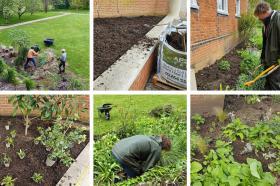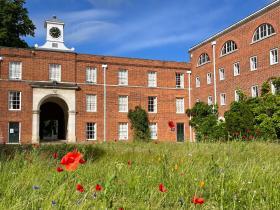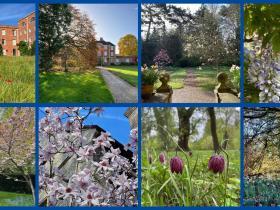
Our ambitious plans to make LMH's gardens among the best in Oxford ahead of our 150th Anniversary celebrations
Nestled at the end of Norham Gardens, LMH’s grounds have long formed a central part of the College’s identity, offering solace and inspiration to students and alumni alike. The significance of our gardens cannot be overstated. For many, they are the very heart of the place, shaping fond memories and influencing decisions to choose LMH over other colleges in central Oxford. As we prepare to mark a significant milestone in our history in 2028-2029, there is a collective vision to enhance and redefine the role of the gardens for generations to come.
At the centre of this vision lies a commitment to preserving the historical and botanical richness of the gardens, while also championing vital sustainability and biodiversity goals. The aim is to transform the gardens into a vibrant, immersive space that reflects our academic excellence and pioneering spirit.
Under the guidance of Jenny Rose Carey Head Gardener, Oakley Loudon, plans have been set in motion. Drawing upon the expertise of landscape architects Colvin and Moggridge, as well as acclaimed plant hunter and nurseryman Paul Barney, of Edulis Nurseries, the Garden team is embarking on an ambitious journey.
One of the key objectives is to realign the planting to complement the College’s architecture, ensuring year- round interest and visual harmony, highlighting our unique character. The team has already cleared overgrown borders in Wolfson Quad and around the Bar, and have worked to sharpen existing features such as topiaries and landscaped lawns. The goal is to ensure that our garden is considered among the very best of Oxford colleges.
In Oakley’s words, “Our goal is to create a garden that not only reflects LMH’s rich heritage but also inspires and nourishes all who encounter it. We want to build upon the essence that is already here, to steer it in a healthy way toward flourishing as its most expressive and charming character. We want our garden to be a bridge to experience, enjoyment, connection and education. A sense of place, readily available, to merge with the beauty of nature in all its forms, in the ways only a true garden can offer.”
We want to create a place that is:
- Immersive: Charming and unique within Oxford. A place to walk, sit, be, share, ponder, solve, meet, inspire, nourish, or celebrate.
- Horticulturally stimulating: Rich with varied and interesting plants. True gardening is an intersection of human culture and nature interrupted; Interrupted with discernment, aesthetic or practical choice, from observation and response. How the world's gardeners work is exceptionally diverse and place-specific and we have opportunities to sample and learn from that diversity, to inform our own expression of creative gardening.
- Easy to engage with: A garden is available to be met, as a relationship amongst the many facets of the lives of all the people who live, work, and visit our College. Quietly present and accessible, a support for the community. It is always available but it requires engagement to deepen our experience. Once individuals know how to engage deeply with a place, it is a skill they can carry with them for life.
- Easy to access: The great benefits we want to establish for visitors to the LMH gardens should not only be available to certain groups of people. Getting to the gardens and getting around the gardens should be easy for all.
- Instructive, educative: To increase the benefits our gardens can provide, we should make information available – what is here, what do we know about this species or specimen, where can we go, how do we find our way. Structuring and making available the knowledge beneath the surface provides not only help to those already engaged but makes opportunities available for those who are less so - what we might discover, the serendipity of chance encounter, and a reference for curiosity to develop.
- Diverse: Our gardens support much more than human life. We have a unique site with a broad range of different conditions. We have the river and the ditch. Lower levels of the garden have a different quality of soil to the higher elevations of the borders around the buildings. We have full sun and heat, partial or deep shade, with both dry and moisture-retentive areas. With this broad range of specifics, our gardens provide homes for a multitude of organisms – plants, shrubs, trees, insects, reptiles, birds and animals. We also have an inextricable relationship with water at LMH, and we influence the water quality through the drainage of the site, particularly that which flows back in to the river, and all our soil. This is special and we have a responsibility to manage it, help it thrive, and in turn our community of species can thrive and take sanctuary here. We are a provider of habitats and nurturer of biodiversity.
- Resilient: Even in recent years we have seen changes to the growing environments in our gardens. Floods have become more frequent, winters warmer and wetter, summers drier. The habitat is changing and when we are making growing decisions that will last for decades, we need to make considered choices about what will thrive here in the future.
Support the LMH Garden Project
Want to help us achieve our vision for the College's gardens? You can donate to support this project via our website.
Our Gardens
To return to the main LMH Gardens page, please click on the link below.

